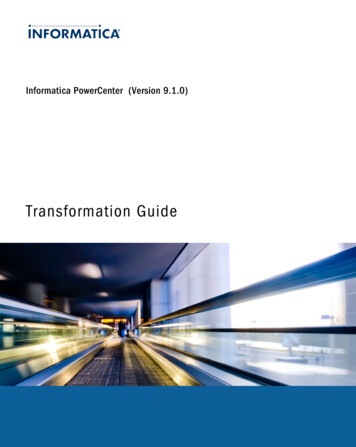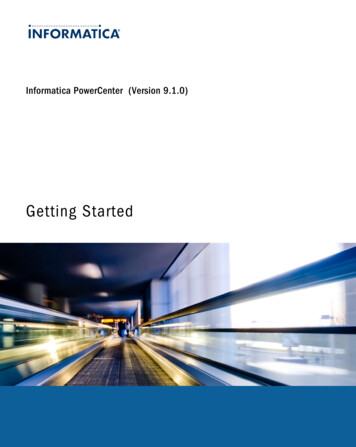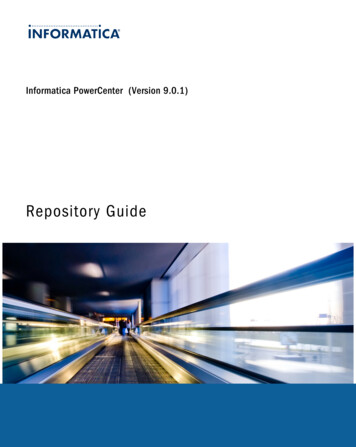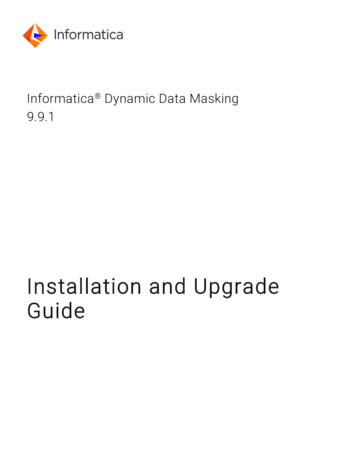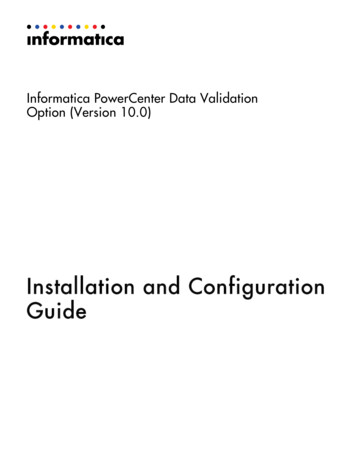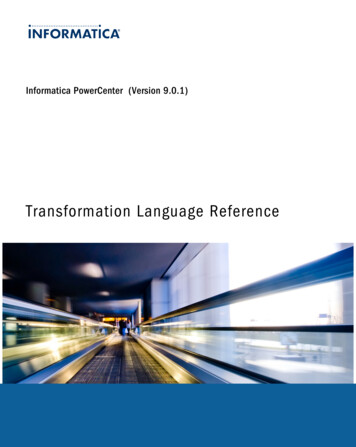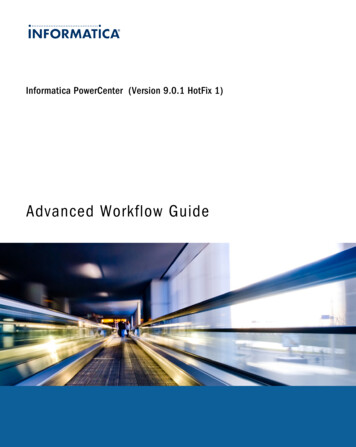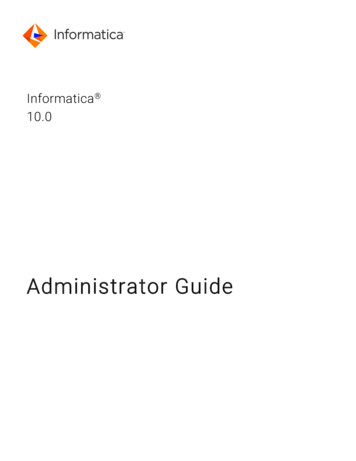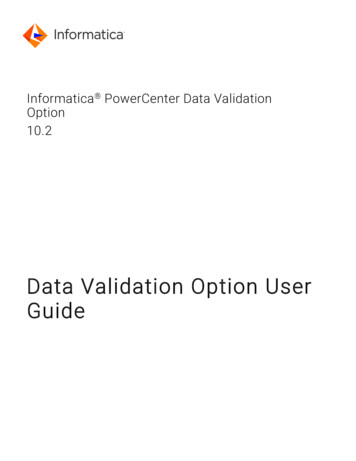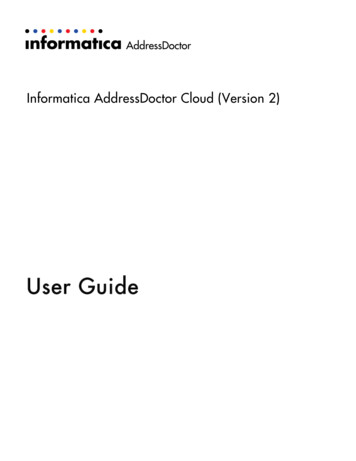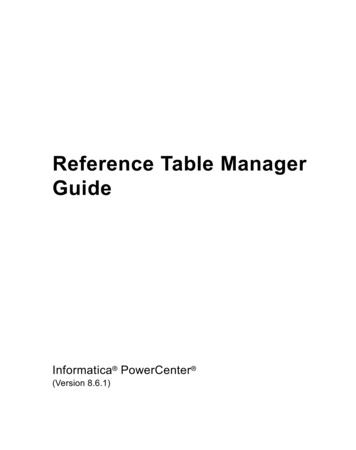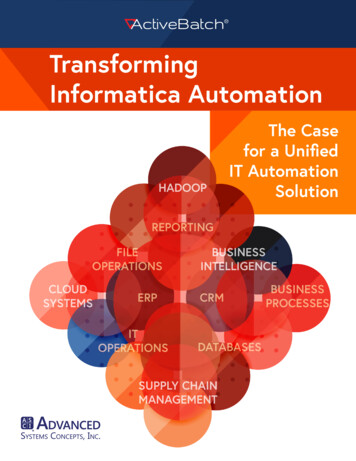
Transcription
TransformingInformatica AutomationHADOOPThe Casefor a UnifiedIT SUPPLY CHAINMANAGEMENTBUSINESSPROCESSES
Handling the flow of growing amounts of structured andunstructured data from multiple sources throughout theenterprise is a complex process. Whether moving transactionaldata so that it can be reported upon, migrating application data fromold systems to new ones, or integrating data from external suppliers orpartners, the reliable management of data streams can present a challengeto IT organizations. Because these movements of data can be scheduled on aregular basis or executed based on specific triggers, ETL and data warehousingprocesses inherently lend themselves to automation. Automation brings a host ofbenefits to these processes including faster delivery times, improved productivity,reduced cost, decreased risk of error, and higher levels of data quality, amongothers. But the automation tools commonly available often don’t provide theflexibility that is needed for granular and end-to-end automation. For mostorganizations a different approach, a unified IT automation solution, is needed toachieve all the benefits that automation can provide.ANALYZING THREE TRADITIONAL APPROACHES TOETL AUTOMATIONIn order to facilitate the extraction, transformation, and loading (ETL) of dataused in building enterprise data warehouses, many organizations have turnedto Informatica’s industry-leading data management solutions, InformaticaPowerCenter and Informatica Cloud. When it comes to automating and schedulingInformatica PowerCenter and Cloud processes, there are a few differentapproaches that are traditionally taken. Typically, we see organizations automatetheir Informatica data warehousing/ETL processes using one of three methods,each of which comes with its own set of pros and cons outlined in the tables.2
BUILT-IN SCHEDULERSProsCome with Informatica applicationMeet the requirements for verybasic Informatica-only schedulingConsCapabilities lack the flexibility needed to runInformatica workflows or tasks on complexcustom schedules or event-based triggersNo end-to-end scheduling capabilitiesPMCMDProsConsNot always easy to useBuilt-in with InformaticaNot designed to easily pass data or managedependencies between systemsOften need to supplement PMCMD withcustom scriptCUSTOM SCRIPTING OR HOMEGROWN SOLUTIONProsConsEliminates some of the need to learnnew technologies or applicationspecific scheduling toolsNeed for senior-level resources to research,write and testTargeted approach to schedule anexecutable or processDifficult to maintain; code can break overtime as processes changeTime-consuming and error-prone3
As you can see, the challenge with these approachesis that they limit users in realizing the full benefitsthat automation can provide, both from the perspective ofautomating Informatica PowerCenter and Cloud processes, aswell as incorporating Informatica processes with non-Informaticaprocesses, such IT operations, business processes, file operations, BI/reporting, and more, to achieve true end-to-end automation.INFORMATICA & BEYOND: THE CASE FOR A UNIFIEDIT AUTOMATION SOLUTIONEnterprise IT automation and job scheduling solutions provide the mostcomprehensive, advanced way to automate both Informatica workflowsand tasks as well as incorporate those workflows and tasks with nonInformatica applications.Think about why you implemented an ETL tool in the first place. Yourorganization, with its ever-increasing amount of data, needed to evolvefrom manual management of this data to sophisticated and complexsystems, including CRM, ERP, and others, each with its own datastore. Different parts of the organization, maybe in different physicallocations or perhaps not, were running different applications on differentarchitectures. So what happened when you needed to compile a reportfor an audit, for example? You pulled the required data from each4
disparate system and manually consolidated it into a report, but thatwas neither practical nor efficient and almost certainly resulted in errors.An ETL tool, like Informatica PowerCenter, solved those problems bypulling data from multiple sources and transforming it in a way thebusiness could use and easily and reliably report on.The case for IT automation isn’t muchdifferent.According to research by Gartner, most largeorganizations have between three and eight differentautomation tools in their environments, and managingthese disparate automation tools brings additional layers ofcomplexity. Instead of moving forward faster, IT departmentsare held back. Compounding the problem, IT budgets aren’tincreasing much; according to John-David Lovelock, ResearchVice President at Gartner, global IT spending will only rise1.6% this year and will only grow 2-3% from 2017 to 2020.The only way to combat these issues is a modern,architectural IT automation strategy that consolidatessilos of automation within a single framework, givingorganizations the IT agility they need while reducing thecost of change.5
PICKING THE RIGHT IT AUTOMATION SOLUTIONAs an Informatica PowerCenter or Cloud user, there are special considerations,requirements, and features you should look for when selecting an IT automationsolution. Here is a list of just some of those features, many of which specificallyapply to the unique challenges of automating PowerCenter and Cloud workflows.Ability to build and automate end-to-end workflows across Informatica and nonInformatica applications without custom scriptingA library of pre-built, pre-tested integrations that allow you to easily, yet powerfullydrag-and-drop job steps for Informatica and non-Informatica processes in order tobuild end-to-end workflowsAdvanced date/time scheduling functionality to handle even the most complexcustom schedules (like incorporating holidays, weekends, Fiscal and Gregoriancalendars, and more) without needing to write special codeComplex event-based scheduling capabilities to more easily manage particularautomation requirements, including synchronization and prioritiesAbility to dynamically set runtime parameters to reduce the number of workflowsyou need to manage and maintainAbility to trigger workflows sourced in and across multiple foldersAbility to ensure dependencies have been met, such as ensuring that a particular fileis closed, before starting other dependent workflowsFlow control and conditional logic capabilities that do not require custom scripting(if/then/else statements)Built-in runtime monitoring to proactively monitor a job’s progress and send an alertif an ETL job or other job is running longer than expected; monitoring capabilities forjobs with SLAs to ensure meeting of expected completion requirementsAdvanced runbook, auditing, and logging capabilitiesWorkflow optimizing tools to reduce the time to completion and insight6
ACTIVEBATCH IS TRANSFORMING IT AUTOMATIONActiveBatch IT Automation and Enterprise Job Scheduling provides InformaticaPowerCenter and Cloud users a unique and powerful approach with capabilitiesbeyond the built-in PowerCenter and Cloud schedulers and PMCMD. The ActiveBatchIntegrated Jobs Library provides pre-built, pre-tested, templated integrations thatcan be dragged and dropped to easily and reliably automate PowerCenter and Cloudworkflows. Users can also build workflows into end-to-end processes that pass data andmanage dependencies without the need for custom scripting.Advanced Systems Concepts, Inc., maker of ActiveBatch, is a recognized leader in the ITautomation industry by leading analyst firms such as Gartner, Forrester, and EMA. TheActiveBatch Extensions for Informatica PowerCenter and Informatica Cloud are part ofthe Informatica Marketplace and have each earned the Informatica Seal of Approval.“Advanced Systems Concepts, long-time Informatica Partner andmaker of ActiveBatch IT Automation, offers Informatica PowerCenterand Cloud users a simplified and powerful approach to automatingtheir workflows and tasks. ActiveBatch’s job scheduling capabilitiesand rich library of pre-built integrations help organizations moreeasily and reliably build end-to-end workflows across Informatica andnon-Informatica applications. The result is a streamlined, reliableintegration that is unparalleled in ease of use.”Ronen SchwartzSenior Vice President & General Manager,Data Integration and Cloud Integration, Informatica7
RedefiningIT Automationwww.ActiveBatch.com/InformaticaDownload theOverviewWatch theVideoVisitActiveBatchon theInformaticaMarketplaceRead theCustomerCase Study
Vice President at Gartner, global IT spending will only rise 1.6% this year and will only grow 2-3% from 2017 to 2020. . Big Data Automation, IT Process Automation, Business Process Automation, Managed File Transfer, Informatica, Informatica Cloud, Informatica PowerCenter, Advanced Systems Concepts, Job Scheduler, Job Scheduling, Jobs Library .
